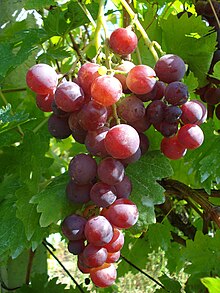Cardinal (grape)
In this article, we are going to address the topic of Cardinal (grape) from an innovative and relevant perspective for our readers. Whether Cardinal (grape) is a person, a topic, a date or another element, it is crucial to understand its impact on the world today and how it is influencing different aspects of society. Through an in-depth and detailed analysis, we will explore the many facets of Cardinal (grape) and its implications in various areas. Our goal is to provide our readers with a complete and up-to-date understanding of Cardinal (grape), so that they can stay abreast of the latest developments and trends related to this topic.
| Cardinal | |
|---|---|
| Grape (Vitis) | |
 Cardinal grape cluster grown in Medjimurje County wine subregion, northern Croatia | |
| Color of berry skin | Rose |
| Species | Vitis vinifera |
| Also called | Red cardinal |
| Origin | California |
| VIVC number | 2091 |
Cardinal is a table grape variety first produced in California in 1939.
The grape is a cross of the Königin der Weingärten and Alphonse-lavallée table grapes, according to latest research. In the United States, Bulgaria, North Macedonia, Croatia, France, Italy, Romania, Spain, and Portugal the grape is used as a typical table grape for eating and making raisins. In Thailand and Vietnam it is used widely in wine production. It is the main parent of the Blanc du Bois subtropical wine grape.
The cultivation of the variety was introduced in the Philippines in the 1970s where it is mainly grown in the Ilocos region.
References
- ^ Vitis International Variety Catalogue http://www.vivc.de/index.php?r=passport%2Fview&id=2091
- ^ J. Robinson (ed) "The Oxford Companion to Wine" Third Edition pg 139 Oxford University Press 2006 ISBN 0-19-860990-6
- ^ "Codex Standard on Table Grapes undergoing Adoption to Philippine National Standard: Field Date Gathering Conducted". Philippine Information Agency. Bureau of Agriculture and Fisheries Standards. 26 May 2021. Retrieved 26 May 2021.